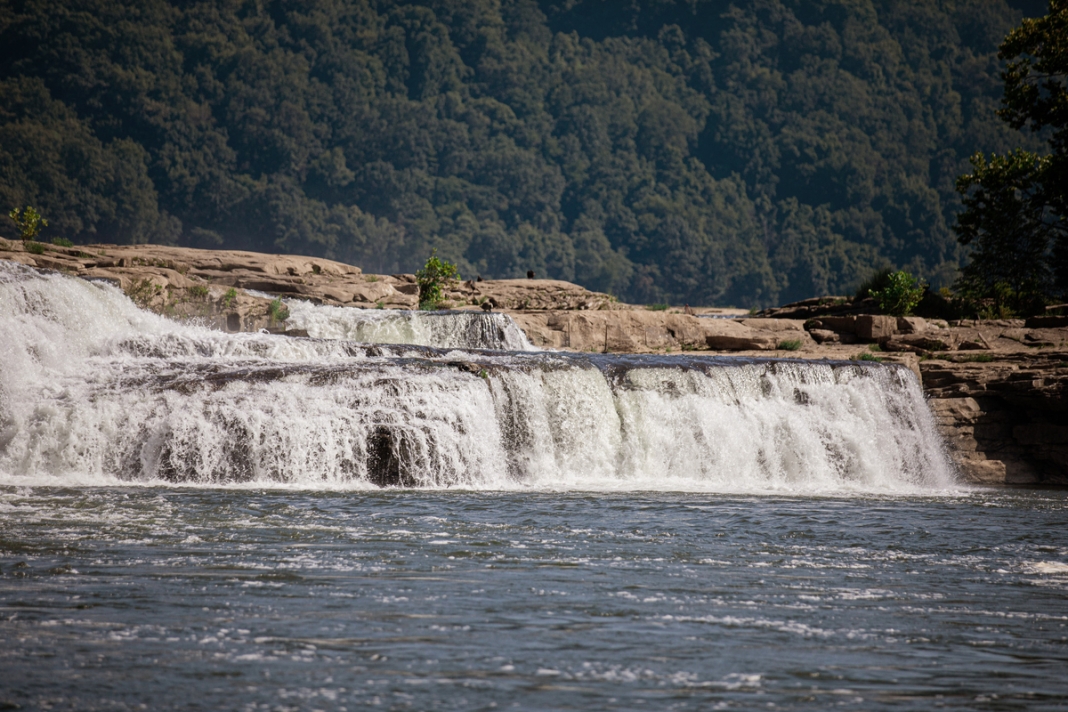QUNNIMONT, W.Va. — The New River Gorge National Park and Preserve in West Virginia is a treasure trove of sights, where forested mountain walls conceal ghost towns, industrial ruins, and lost historical gems.
An overlooked monument in the gorge
Some sights require more effort to find than others, however, though travelers on WV-41 passing through the gorge have the opportunity to see one of its most obscure.
Forgotten and long neglected, the imposing monument to ‘Colonel’ Joe Beury honors the memory of the first person to ship coal from the New River Gorge. Mostly hidden, the obelisk’s tip peeks above the roadside along the highway between Quinnimont and Prince, West Virginia. A short walk downhill reveals its full stature—a towering stone structure encircled by an ornate wrought-iron fence
Of rusticated granite, the monument stands twenty-five feet tall and weighs fifty-five tons and was raised in Beury's honor by other industrialists who worked with him the the New River Coalfield.
The Beury Monument: a landmark of New River Gorge coal history
The Beury Monument stands as a silent reminder of the region’s rich industrial history. Notably, it faces away from the road, instead overlooking the New River and the railroad below.
In the years following its establishment in 1863, West Virginia remained largely rural, isolated, and undeveloped. Large quantities of important natural resources were known to be present, but the mountainous terrain made it challenging to extract them. West Virginia’s most important piece of transportation infrastructure, the Baltimore & Ohio Railroad, traversed only the northern fringes of the state.
The birth of the coal industry in the New River Gorge
Everything changed with the construction of the Chesapeake & Ohio Railway in southern West Virginia during the early 1870s. For the first time, the state’s rich southern coal reserves were made available to the outside world. The railroad provided a link from the Atlantic Ocean in eastern Virginia to the Ohio River, terminating at the new city of Huntington, West Virginia. Mines and coal company towns emerged along the line in an unprecedented burst of economic activity for West Virginia.
At the same time that the C&O was under construction, mining entrepreneurs were scouring the New River Gorge and discovered vast deposits of high-quality bituminous coal, which burned well and emitted relatively little smoke. This led to the region’s coal being dubbed “New River Smokeless Coal.” One of the first people to act upon this promising resource was a young man named Joseph Beury.
Colonel Beury and the first shipment of New River Coal
Beury was born in Pennsylvania in 1842. His early years were spent working and learning in his father’s coal mines in the anthracite fields of the eastern state. Sometime after the Civil War, he moved to West Virginia and quickly recognized the economic potential "smokeless" coal would have once the C&O Railway arrived.
Of particular interest to Beury was the town of Quinnimont along the New River. It was the oldest community in the gorge, having first been settled in 1827. Seeking to preempt competitors, Beury began mining coal there in 1872 before the railway was even operational. It wouldn’t be completed until the following year.
His enterprise, named the "New River Coal Company" (not to be confused with the later New River Company), was the first mine opened in the gorge. By the time the C&O began running trains in 1873, he had already stockpiled coal and sent out the first shipment sometime that autumn.
The first railcar of coal out of Quinnimont signaled a turning point in the history of the gorge. Within decades, the region was transformed with dozens of towns, thousands of people, and countless mines. Communities such as Thurmond, Nuttallburg, and Kaymoor produced coal that was sent all over the nation.
When the industry began its permanent decline in the mid-1900s and the gorge was largely depopulated, the seeds were sown for the thriving tourism industry that exists there today.

Beury’s prospered greatly after that first coal shipment in 1873. He became one of southern West Virginia’s first "coal barons" and opened many more mines around the gorge, establishing company towns named after himself at "Beury" and "Lawton." He lived in a lavish mansion with his family at Beury until he died in 1903. It later became a ghost town, and little remains.
Sometime after his death, a group of his colleagues in the coal industry pooled $30,000 to erect this obelisk in his honor. Little else is known about the monument’s inception.
The National Park Service states that it was constructed in the 1920s, but does not have a more precise date. A plaque on the front, facing the river and railroad, reads “The first New River smokeless coal was mined and shipped from Fire Creek Seam at Quinnimont by Joseph Lawton Beury in 1873. This memorial was erected by his coal associates in the New River District.”
Quinnimont was chosen as the site for the monument since it was where the first shipment of New River coal departed. Its location might seem strange and isolated today, but at the time, it was in a prominent position.
During the 1920s, the hillsides would have been clear-cut and dotted with homes, buildings, and mineshafts. The obelisk would have had a clear view of the New River and the railroad tracks. It also stood in close proximity to commercial businesses, churches, and other things that would have brought in people and increased its visibility.
Over the decades, as the forests grew back, the coal mines shuttered, and people moved away, the monument was forgotten. The obelisk was enveloped in trees and brush. Several small commercial buildings along WV-42 further obscured it from view. What was once Quinnimont’s commercial hub is virtually unrecognizable.
In the 2010s, the last commercial buildings in the town were demolished, and the brush was cut back by Ralph Plumley, who owned the adjacent property, uncovering the long-lost monument.

The monument is located just a short distance from several other historic sites, including the Quinnimont Missionary Baptist Church, the Prince Train Station, and the Prince Brothers’ General Store, making it worth a short visit. A small gravel pull-over site allows drivers to easily park and approach it.
The National Park Service has not placed any interpretive signs to explain the monument’s history, but more information about it and Joseph Beury is available on the New River Gorge National Park & Preserve website.
Directions to the Beury Monument
The Beury Monument is not hard to find. From US-19 in Beckley, West Virginia, follow WV-41 (Stanaford Road) 10.2 miles to a gravel parking lot next to the monument. Its address is Beury Monument, 10294 Stanaford Rd., Prince, WV 25907. Its Google coordinates are: 37.857662590996114, -81.0481438248277.
Map showing Beury Monument
Sign up for a FREE copy of West Virginia Explorer Magazine in your email weekly. Sign me up!







Thanks so much for sharing. We will have to plan a visit to see the monument.
The monument was close to the elementary school at Quinnimont. The school is no longer there.
Nice article of historical significance.
I ran into that I didn’t know if it was a grave or a what squirrel hunting back in mid 1970’s as a kid.
One of the commercial buildings that obscured the view of the monument and was later razed was a gas station that changed hands a number of times. My father owned and a brother managed it in the 60s and 70s. The monument at that time was, in fact, neglected and surrounded by brush.